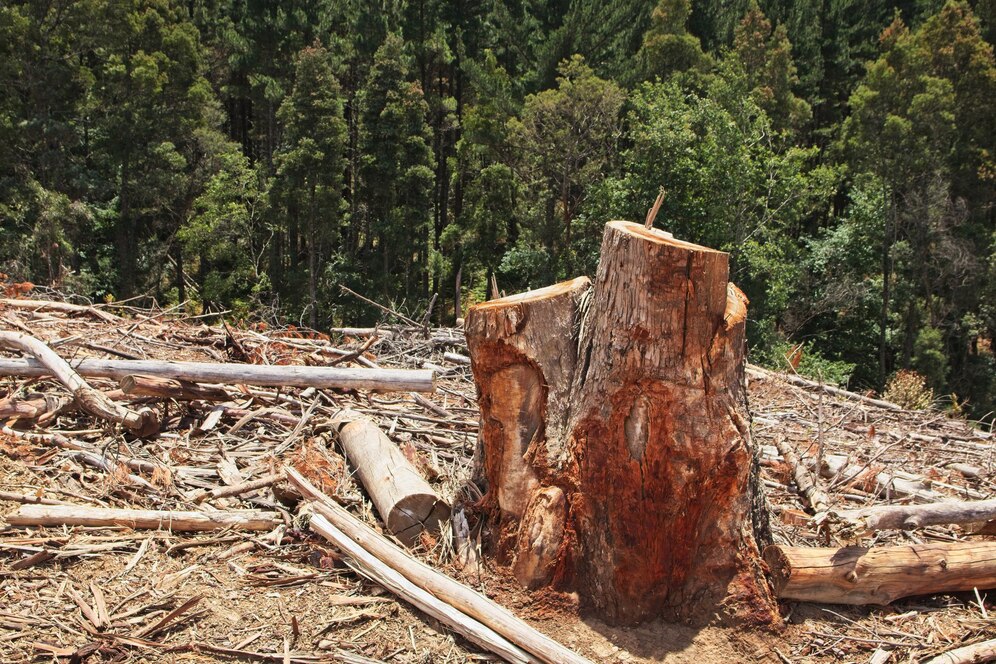Why Removing Tree Stump Is Just as Important as Cutting Trees

4.It’s easy to think that a tree’s removal is complete, but the stump that remains after a tree is chopped down can soon grow into more than simply an eyesore. As the stump ages, it starts to degrade and draws ants and termites, which may eventually migrate to other parts of your land. It may also turn into a safety risk, particularly if it’s in a busy place where someone could trip over it. Moreover, a stump might obstruct your landscape design’s overall flow and cause problems with lawn maintenance.
Leaving a stump remain can cause problems such as undesired regrowth, where shoots emerge from the roots, or harm to the nearby plants, in addition to the immediate difficulties. In addition to making your yard seem better, stump removal frees up space for additional landscaping tasks like adding more plants or garden beds or just keeping the area safer and cleaner. Maintaining the health of your property and the safety of people who use it depends heavily on appropriate stump removal.
The Risks of Leaving Tree Stumps
1. Bringing in Pests
The possibility of a tree stump turning into a bug breeding ground is one of the main dangers associated with keeping one in your yard. Termites, ants, and beetles are drawn to the decaying stump and may eventually infect other trees or even your house. Once these pests become established, getting rid of them can be difficult and expensive.
2. Resulting in Regrowth
It’s not always the case that a tree stump indicates the tree is dying. On the remaining stump, fresh shoots may occasionally begin to develop. Unwanted new trees or bushes may result from this regrowth, which will need ongoing trimming or eradication. Furthermore, this regeneration is weak and prone to injury since it frequently lacks the structural strength of a fully grown tree.
3. Risks to Safety
Tree stumps can be hazardous, particularly if they’re close to play areas or in places where there is a lot of foot activity. They can injure kids, dogs, and anybody else strolling through your yard because they are simple to trip over. Remaining exposed roots can also harm lawn equipment like mowers and provide a trip hazard.
4. Aesthetic Upheaval
Tree stumps aren’t the most beautiful sight in a yard, let’s face it. They may cause an eyesore that detracts from the aesthetic attractiveness of your garden by breaking the natural flow of your landscaping. You can regain the area by removing the stump and using it to grow grass, plant flowers, or add a new design feature.
Benefits of Tree Stump Removal
1. Keeping Diseases and Pests at Bay
You can reduce the possibility of a tree stump serving as a haven for pests and a disease host by getting rid of it. This keeps your yard safe and guarantees that any other trees or plants you have won’t be negatively impacted by a decaying stump, allowing them to grow and thrive.
2. Making Room for Landscape
Your yard gains vital area when you remove stumps. Whether your landscaping goal is to create a garden, plant a new tree, or just extend your grass, removing the stump will free up more space.
3. Increasing Security
By removing stumps, you may make your home safer for your family, your pets, and your visitors by lowering the possibility of accidents and injuries. Additionally, it keeps your yard equipment from getting damaged by getting rid of stubborn roots that can get tangled in trimmers or lawnmowers.
4. Increasing Curb Appeal
Your property looks and feels better overall with a tidy, stump-free yard. Stump removal helps preserve a tidy, well-kept landscaping, which may greatly improve the curb appeal and possibly increase the value of your house.
How Tree Stump Removal Works
There are various approaches to tree stump removal, and each has advantages and disadvantages.
crushing
One of the most popular and effective techniques for getting rid of tree stumps is stump grinding. The stump is reduced to wood chips by a machine, but the roots remain underground. Although this technique is rapid and doesn’t require much digging, the roots will eventually deteriorate.
Manual Elimination
Hand removal of tiny stumps is an option. In order to liberate the stump, this entails excavating the area surrounding it and removing the roots. Even though it takes a lot of work, this technique guarantees total removal of the roots and stump, stopping any further development.
Chemical Elimination
Over time, it will be simpler to remove the stump since chemicals can be applied to accelerate the disintegration process. While it takes longer, this technique might be perfect for harder-to-reach stumps or for people who would rather take a less intrusive approach.
Flamming
Stump removal sometimes involves burning the tree. But use caution when using this strategy, and only do it in places where it’s both safe and allowed. Because of the hazards to the environment and public safety, burning is usually done as a last resort.
Conclusion
Tree stump clearance is a crucial component of tree pruning that cannot be disregarded. Removing the stump will help your property in the long run, whether you’re dealing with pests, safety issues, or just want to make your yard seem better. You may make an outdoor place that is safer, healthier, and more aesthetically pleasing by removing the concerns that come with having an abandoned tree stump. Consulting an expert may help you determine the finest approach for your needs if you’re unclear on how to get rid of a stump on your property.
